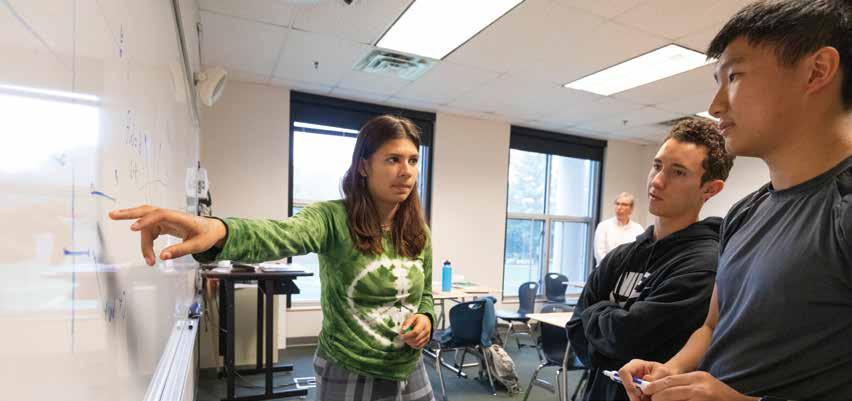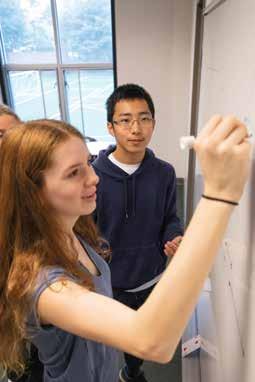
2 minute read
. THIS
HIGH SCHOOL TEACHERS ADOPT THE “THINKING CLASSROOMS”
MATH MODEL.
Advertisement
HIGH SCHOOL MATH TEACHERS Beth Stafford and Tom Spilsbury have adopted a model that encourages students to actively think about how to solve a math problem instead of passively mimicking the steps demonstrated by teachers.
This “Thinking Classrooms” model is the brainchild of Peter Liljedahl, a math professor at Canada’s Simon Fraser University who developed 14 practices to help students better engage with math. For more than a decade, Liljedahl observed roughly 400 reputable math teachers in traditional K-12 classrooms and concluded that institutional norms and habits often enable “non-thinking” student behaviors. His model aims to disrupt those norms and encourage research-based practices that show the greatest increase in student thinking.
Beth, who teaches geometry extended and linear algebra, said she started integrating some of those principles into her classrooms in 2017. Tom began doing the same in the spring of 2021 in his calculus, multivariable calculus, and differential equations classes.

“We’ve been collaborating and really thinking through how to structure these lessons in a way that enables students to discover problem-solving concepts for themselves instead of having us deliver the concepts to them,” Beth said.
In keeping with two of Liljedahl’s methods, Beth and Tom have their students work on “vertical non-permanent surfaces” (specifically whiteboards) in “visibly random groups” of three peers. These concepts may sound simple, but Liljedahl’s work shows they yield impressive gains in terms of student enthusiasm for and engagement in mathematical concepts.
For starters, it’s important for students to know–and actually witness for themselves–that they are grouped with others daily in a way that is not sociallyengineered or based on preconceived notions about their abilities, instilling the idea that each student is capable, Beth said.
ASHA ADIGA-BIRO ’23, LUKE COHEN ’23, AND KEVIN XIA ’25 TACKLE A MATH PROBLEM.
Standing at a whiteboard enables students to easily erase mistakes and try again. It also keeps them actively engaged and encourages on-task talk within and between groups. “They are not siloed and sedentary,” said Tom, adding that each group gets one marker to encourage collaboration. “The groups are also exposed to each other in that setting, so that when one group is stuck, they can look around and borrow ideas from other groups and move forward.”
Beth said she’s witnessed students share more knowledge more quickly than they would seated at their desks, a concept that Liljedahl calls “knowledge mobility.” In effect, students are relying less on their teachers and more on each other to solve problems, which enhances their thinking skills. “Student feedback has been very positive so far,” Beth said.
Beth and Tom have been sharing Liljedahl’s 14-point method with other math educators. At GDS, they’ve formed a book club of seven High School and Middle School teachers that meets roughly once a month to discuss various chapters in Liljedahl’s book, Building Thinking Classrooms in Mathematics. (“Word is spreading,” Tom said.) In December, they drew a crowd at a conference for the National Council of Teachers and Mathematics, where they presented a paper on how to apply Liljedahl’s methods in calculus classes.
“Sharing what we’ve been working so hard on was pretty great,” Beth said. “We just want to build community around using this model.”






